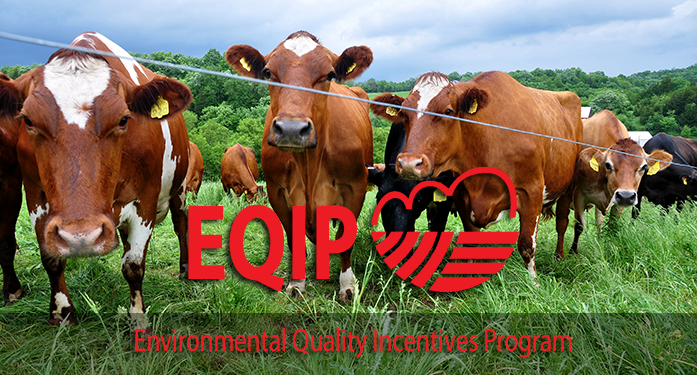Practical Farmers Use EQIP to Build Business – Deadline Mar 17 for EQIP 2017
Today I’d like to introduce you to two farmers: Jenny Quiner and Dusty Farnsworth. Jenny runs a ¼ acre urban vegetable farm in Des Moines while Dusty farms several hundred acres of organic and conventional row crops with integrated hogs and cattle. What do these two have in common besides their membership in Practical Farmers of Iowa? They both use the Environmental Quality Incentives Program (EQIP) to develop infrastructure and implement environmental protection measures on their farms.

EQIP is a federal cost-share program for farmers who implement any one (or more!) of a large list of approved practices. Though EQIP applications are accepted on a continuous basis, March 17, 2017 is the deadline to submit mid-year 2017 applications for timely response. In 2016, 122 approved practices included projects such as installing windbreaks, bioreactors, and pollinator habitat or writing grazing and nutrient management plans. Approved practices are determined on a county by county basis depending on the environmental and conservation needs of the area. This map shows the 2017 lists of approved practices by clicking through for each county.
All approved practices qualify for 50% cost share, but certain factors such as historically under-served farmer status and/or alignment with federal initiative policies cause the cost-share rate to climb to a maximum of 90% (specifics on page 1 of this document). Though formulated as a percent, the payment is actually a flat rate based on the cost of implementing the practice in your area.

Jenny Quiner (far right) harvests greens at her urban vegetable farm in Des Moines
Our featured farmers have used this federal program in very different ways. This year Jenny will use EQIP to install a high tunnel, significantly increasing her production area. She says “I only see positives with how it’s going to impact my business. I recognize that high tunnels are more work, but I understand that and embrace it. The tunnel will allow us to get early and late season greens and we’ll also use it for tomato production.”
Her advice on making the most of the EQIP program is, “Be proactive. Stay on top of it and have a good relationship with your representative in the NRCS office.” As a beginning farmer, and thus a historically under-served farmer, Jenny qualifies for a 90% cost share rate on her high tunnel because it falls under the federal seasonal high tunnel initiative so, in her words, “it was a no-brainer to try and make it work.”

Dusty Farnsworth (center, red baseball cap) shows off hogs on his farm to IDALS Secretary Bill Northey (far right) and Representative David Young (left)
Dusty has had three different EQIP grants on the operations he manages. His first EQIP grant paid for cover crops on his corn, soybean, and small grain acres. Since that grant expired, he now has two active EQIP projects. One is a grazing program that cost shares fencing and the other is an organic transition project which cost-shares implementation of diverse rotations and also includes some fencing. He says, “It’s big bucks to put in all this fence – the EQIP grant at least pays for labor. They pay you a flat rate per project and they don’t care if you do it or you hire a contractor, so it can keep you working. It’s exactly what a small farmer needs to keep themselves employed on farm.”
When applying for EQIP funding, he says, “number one piece of advice is to start the process as early in advance as possible and don’t expect it to be quick. Give your local NRCS office plenty of time to work through your application because there’s multiple rankings and lots of paperwork and planning. Like farmers, those NRCS offices have a very heavy workload.”
The National Sustainable Agriculture Coalition EQIP page is a good resource for understanding the program and whether it’s a good fit for you. When you’re read to apply or want to learn more about Iowa specifics, visit the Iowa NRCS’s page or your local NRCS office.
